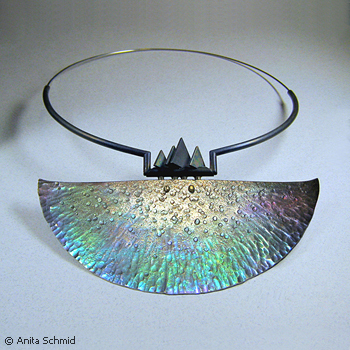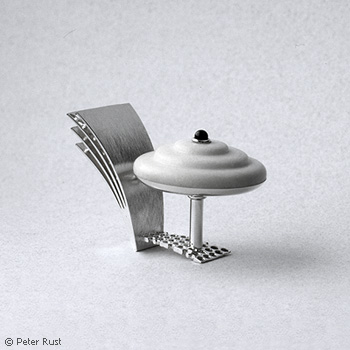My brooches and necklaces are based on studies of different organic and non-organic forms from nature. I look at myself as a discoverer of beauty in radiolarians, crystalloid structures, plants, insects or other nasty little creatures. They give me the basic themes witch I develop further or make abstractions of them. By doing this in extreme enlarging I lead the human eye to the magnificence in microcosm.
My favourite materials are titanium in combination with silver. I have developed my own methods to colour titanium and shape it be embossing, chasing and repoussť-work. The necessary joints between the titanium- and the silver parts have often both an esthetical and a technical function; they make the different parts grow together to a harmonic unit.
If a bit of the fascination I feel on these mostly unseen small forms, details, structures, colours and textures is jumping over to the audience, then I know, that I have succeeded in my work
Anita Schmid
For Peter Rust the ring is the most challenging jewellery genre. It interests him particularly as a three-dimensional form. By giving the ring itself a square shape, he makes it serve as a pedestal. Hence the rings become like independent miniature sculptures.
Previously Rust usually worked on the base of a particular theme. "Domestic Situations" is the title of a series of rings made of silver, brass and iron from the late 1980s. Abstractions of human heads were the main motif, and the situations they were placed in referred to everything from standardized thinking to exclusionary practise. References to current topics can still be traced in the pieces he makes, but he no longer works in series and his idiom has become more complex.
Rust likes to combine different materials, and the investigation of the properties of different materials has also had a central place in his production. A series of rings from the early 90s is based in three fixed shapes that were executed in marble, granite, ebony with dots of pewter and silver. This results in rings of very different characters, something that tells us how much the choice of material means for our experience of form. In his latest rings there is even a suggestion of humour when a pinhead of coloured glass is used as striking element.
From the book NORDIC JEWELLERY by Jorunn Veiteberg

